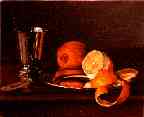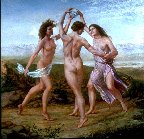 Still Life, an Historical Overview by Elsie Russell
Still Life, an Historical Overview by Elsie Russell Still Life, an Historical Overview by Elsie Russell
Still Life, an Historical Overview by Elsie Russell
Carravaggio's (Michelangelo Merisi, 1573-1610) sublime "Basket of Fruit" exemplifies this new interest in immortalizing humble but beautiful subjects for their own sake, which had developed primarily in the north, and had spread to Italy, France and especially, Spain. There, the austere and mystical paintings of artists like Sanchez Cotán (1531-1588) and Francisco de Zurbaran (1598-1664), and later Luis Melendez (1716-1780), called "Bodegones", or pictures of food and humble household objects, inhabit the picture with a noble Zen stillness; meditations on humility and the sacredness of the moment. Rembrandt Van Rijn's (1606-1669) "Side of Beef"(1665) in the Louvre Museum, although not a table still life, owes something to this tradition. Francisco Goya's (1746-1828) "Slices of Salmon" expresses the same raw spirit of observation, and paves the way for the bravura still lifes of Édouard Manet (1832-1883) in France.
In contrast, it was in 17th century Netherlands and Flanders that still life really blossomed with riotous displays of flowers like those of Jan Breughel the Elder (1568-1625), Jan Davidsz de Heem (1606-1684), Jan Huysum (1682-1749) or Rachele Ruysch (1684-1750. Another favorite were opulent tables, set with luxurious foods, crystal and silver like those of Willem Kalf (1622-1693), Abraham Van Beyren (1620-1690) or Gerrit Willemz Heda (active1642-1702), or with the trophies of a successful hunt or haul of the net like the works of Ruben's collaborator Frans Snyders (1579-1657).
But in French still life it is Jean-Baptiste-Siméon Chardin (1699-1779) who was accepted into the French academy with his "1738 "La Raie", an extravagant collection of fruits of the sea which directly relates back to the Dutch of the previous century, who reigns supreme. Chardin was a master of many types of still life, from the humble architectural kitchen pieces of his early years to the miraculous set tables, allegories, and poetic arrangements of fruit of his mature years. Denis Diderot (1713-1784), author of the "Encyclopedia", was so moved that he exclaimed, "This is unfathomable wizardry. Thick coats of color are laid one on top of another, and their effect transpires from below upwards. At other times one might suppose that a mist had blown over the canvas: or again that a light foam had been thrown over it Draw close and everything becomes blurred, flattens out and disappears: draw away and everything is recreated and reproduced." Anne Valleyer Coster (1744-1818) was a follower of Chardin's. Her work, though often mistaken for his, is infinitely more delicate of touch, and has some very strange arrangements, like her collection of coral and shells on a stone shelf in the Louvre Museum, which is almost photographic in its precision and depth.
Until the mid-nineteenth century, still life was considered an inferior genre with a limited potential for expressing grand themes. Individual artists ignored this categorizing, of course, but it wasn't until Gustave Courbet (1819-1877) and his philosophy of realism and pure painting that still life began a life as an independent vehicle for form, color and paint surface, divorced from the classifications of the Academy. Later in the century, the revolution led by Manet, Auguste Renoir (1841-1919), Paul Cézanne (1839-1906), Claude Monet (1840-1926) and Vincent Van Gogh (1853-1890) forever closed the door on this debate. Now there is no question that still life can speak eloquently, both formally and poetically as a "noble" genre of fine art. When we admire a plate of oysters by Manet, skulls and clocks by Cézanne, or a vase of irises by Van Gogh all we see is a miraculous interpretation of the world around us. This has utterly changed the way we in which we view the world.
In the Modern age, still life has taken on a new role. Cezanne paints an apple just as he would a woman or a mountain and Georges Braque (1882-1963) paints an apple as a collection of overlapping geometric facets. The inanimate objects in the new still life express the mystery of the world through their relationship with the space they inhabit in a fundamental way: the eye informing the mind of the cosmic correspondences between forms and space. The distillation of form and content to its purest elements, geometry (Juan Gris-1887-1927), color (Henri Matisse-1869-1954), and the symbolic (via the surrealism of Giorgio de Chirico, 1888-1976, and Salvador Dali, 1904-1989) is thoroughly explored in still life of the 20th century. The enigmatic Giorgio Morandi (1890-1964) brought back a spare and formal plasticity to still life with a limited palette reminiscent of Roman painting, and themes that hearken back to the Spanish "bodegones". But it was Pablo Ruiz Picasso (1881-1973) who most exploited the genre, twisting it into previously inconceivable forms using a wide variety of stylistic permutations throughout his long career. On the subject of Picasso's still lifes, Jean Cocteau observed, "Picasso ne fait pas de trompe l'oeil, il fait du trompe l'esprit"(Picasso does not make trompe l'oeil, he makes "trick the spirit").
Artists in the 20th century have used still life as a laboratory for the discovery of new techniques and to test new conceptual arenas. They have done this in both representational and abstract formats, often before expanding into other genres, mixing painting with sculpture, collage, photography, even video and holograms, into works which are still fundamentally considered still life pictures. With all this freedom, where still life is headed is anyone's guess, but the satisfaction of contemplating the depiction of a group of objects on a table is perennial.
"The work of art is itself an ostensible object of handling like certain of the simulated and real objects that compose it. Without a fixed place in nature and submitted to arbitrary and often accidental manipulation, the still life on the table is an objective example of the formed but constantly rearranged, the freely disposable in reality and therefore connate with the idea of artistic liberty. The still life picture, to a greater degree than the landscape or historical painting, owes its composition to the painter, yet more than these seems to represent a piece of everyday reality." (Meyer Schapiro "The Apples of Cezanne: An essay on the meaning of still life" 1968)
Elsie Russell 4/19/2001
Back to Net in Arcadia: The Virtual Museum of Contemporary Classicism